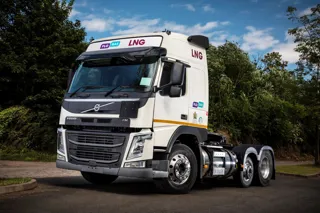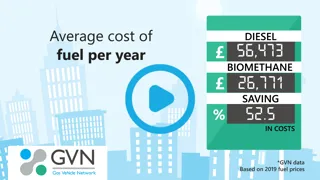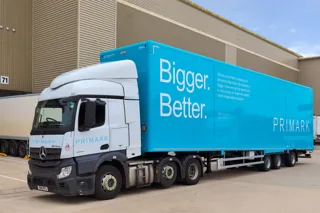Switching heavy goods vehicles (HGVs) to more environmentally friendly gas fuels, including biomethane, bio-compressed natural gas (CNG), and hydrogen, could cut greenhouse gas emissions by up to 38% by 2030.
A new report -The Future Role of Gas in Transport – sets out a roadmap showing how the UK's heavy goods sector, which is responsible about 20 million metric tonnes of CO2 annually, can start to achieve a significant reduction in emissions in the next few years.
The use of hydrogen is critical to the sector achieving net zero, it says.
Dr Angie Needle, director of strategy at Cadent, said: “Hydrogen is an important component of how we reach net zero for transport.
“There are emissions savings we are making today from bio CNG that not only help to decarbonise HGV transport here and now but enable a hydrogen future.
“It is critical that Government recognises the role that green gas will play in decarbonising transport.”
The report calls for:
- Hydrogen to be seen as a key decarbonation option in transport, heat and industry in order to achieve effective scale in production and distribution to bring down costs.
- A ramping up of rollout of biomethane and bio-SNG (Substitute Natural Gas) production capacity to realise the full feedstock potential before direct demand for these fuels' peaks in the 2030s.
- Existing gas networks to be harnessed to deliver hydrogen fuel to heat, industry and transport.
Transport minister Rachel Maclean said: “Last year, the Prime Minster set out an ambitious ten-point plan for a green industrial revolution, and decarbonising transport is a key pillar of this.
“It’s essential that we tackle emissions from the road freight sector, not only to meet our net zero target, but also to create and secure skilled jobs and investment, right across the UK.
“This is why I want to see the UK at the forefront of developing cost-effective, zero-emission HGVs and their refuelling infrastructure, as we build back greener.”
Scotland’s first biomethane refuelling station
The new report is published just as CNG Fuels has started building Scotland’s first public access renewable biomethane HGV refuelling station.
The station near Glasgow will refuel up to 450 lorries a day when it opens in November, enabling HGVs to make low-carbon deliveries across most of Scotland.
Most of England and Wales is already within a 300-mile round trip of a biomethane refuelling station and the new facility will put Inverness and Aberdeen within this range.
Warburtons is the latest major name to announce it is adopting biomethane, following companies such as Hermes, John Lewis, Waitrose and Asda.
Renewable biomethane, says CNG Fuels, is 35%-40% cheaper and cuts vehicle greenhouse gas emissions by up to 85%. From next year it will dispense fully carbon neutral fuel by sourcing biomethane from manure.
Philip Fjeld, CEO of CNG Fuels, said: “Fleet operators keen to cut carbon and save money are switching to biomethane in droves, and our first station in Scotland will play a vital part in our network, allowing gas trucks to make deliveries throughout Britain.
“Biomethane can play a key role in helping the country meet its net zero targets and it is fitting that the station will open just as Glasgow hosts the UN Climate Summit.”
HGVs account for 4.5% of total UK greenhouse gases - and 4.8% in Scotland – so decarbonising the sector is essential to meet the UK’s goal of achieving Net Zero emissions by 2050.
The new station, at the Eurocentral industrial estate off the M8 near Bellshill, is due to open in November.
Steven Gray, Warburtons national transport manager, said: “After extensive alternative-fuel vehicle trials, Warburtons has chosen CNG technology, and specifically biomethane fuel, as our preferred strategy to decarbonise our primary HGV fleet.
“CNG Fuels’ progressive Bio-CNG Station roll-out plans across the UK will allow us to begin our decarbonisation strategy and the Eurocentral refuelling facility is a key location for our fleet.”
David Landy, head of fleet at Hermes, added: “This will allow us to run our Scottish-based fleet on 100% renewable biomethane fuel and push the range of our existing CNG-powered HGV fleet, so vehicles can travel between England and Scotland and take even more emissions off UK roads.”
Key milestones to delivery of a national hydrogen refuelling infrastructure by 2050 are set out in The Future Role of Gas in Transport report:
2021-2025
- Acceleration of biomethane production capacity and the scaling of bio-SNG (Synthetic Natural Gas) production.
- First 100 – 200 hydrogen HGVs demonstrated and industrial hydrogen production underway.
- Localised hydrogen blending in the grid and trials of 100% hydrogen grids in very small regions to demonstrate suitability for heating.
2025-2030
- Achieve full utilisation of biomethane feedstocks and expansion of Bio-SNG production capacity, alongside full national coverage of CNG/LNG refuelling stations for HGVs.
- Rapid ramp up in hydrogen HGV manufacturing capacity and rollout of basic station network in order to support very rapid market transition from 2030.
- Hydrogen blending in the network increases and 100% hydrogen trials expand to deliver the first hydrogen town.
2030-2035
- CNG/LNG HGV sales begin to fall and are replaced by hydrogen HGVs.
- Early CNG/LNG stations start to be upgraded to dispense biomethane and hydrogen.
- Hydrogen blended into the gas network across the country and multiple hydrogen towns/cities are achieved.
2035 – 2040
- The sale of diesel and biomethane fuelled trucks ends having been made possible by the rapid conversion of CNG/LNG filling stations to hydrogen.
- Gas pipelines will be delivering 100% hydrogen to large clusters around the country.
2040 - 2045
- A new milestone is reached as transition of the gas network to deliver hydrogen for use in most of our homes and transport becomes reality.
2050
- Zero-emission HGVs are now the norm – we are close to long-haul HGVs running on hydrogen.
























Login to comment
Comments
No comments have been made yet.